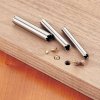JimT
Enthusiastic about Wooden Canoes
The answers to these questions depend on the boat and what you're trying to do. Understand how the boat is constructed, and trust your judgement as you make a game plan. Just don't take it too far apart or you'll end up with a jigsaw puzzle that you may never get back together. Remember that the ribs are steam-bent, and the planking is under some (small) amount of tension, so if you take too much off at once, the hull will begin to relax and spread out over time. That's not good. As you have the boat now, I'd want to be working quickly since you've so much taken out of it. The stringers that support the seats, for example, give a lot of support to your hull, and the seats themselves hold the hull together laterally. All of these are now out of the boat. If you remove the knees and the transom, be sure you've got some bracing to hold everything together or you'll shortly find the boat in a very sad state. Alternatively, get the hull stripped and re-varnished (still best to have some bracing while doing this), and re-install the seat-supporting stringers and the seats before any transom removal. With all of this including the transom, you must decide based on the condition of this particular boat whether it needs more or less tear-down. It's hard to judge these things without seeing it in person. In any case, the more you remove, the more you risk causing damage in the process and the more you have to put back together.
Unless your keelson is damaged, I can't imagine a reason to remove it. "Cleaning up" can certainly be done with it in place, just as you're doing with the ribs and planking.
There may be some salvage sources of mahogany and other woods near you. Surely you're not too far from a good lumber supplier. Try woodfinder.com as a locator. You can use new mahogany and stain, dye or chemically treat it to match the old wood. Another option would be to go to a flea market, antique mall or similar and look for old mahogany pieces that you can scavenge from.
It may have already been said, but one of the best sources for information is the outstanding book The Wood and Canvas Canoe by Jerry Stelmok and Rollin Thurlow, available here:
http://wcha.org/store/wood-canvas-c...tory-construction-restoration-and-maintenance
At $24, this excellent book is a bargain and a must-have for anyone building or restoring wooden canoes and similar boats. There are several other very helpful guides as well, the most recently published here:
http://wcha.org/content/old-canoe-how-restore-your-wood-canvas-canoe
Hope this helps,
Michael
Michael,
thanks so much for such a detailed response. I appreciate the fact that I've removed much of the bracing that gives the boat its structure, and the advice to move quickly on the interior stripping is really what I needed to hear. I will do that and then as you suggest temporarily reinstall the stringers and seats before doing anything about the transom.
And thanks again for the reminder about the Stelmok/Thurlow book, I have that and Mike Elliot's restoration book as well. And my April 2016 issue of Wooden Canoe just showed up yesterday--wish I had had that in hand before taking the first sponson off the other day!! your article was great.
Anyway, at this point I'm concentrating on stripping the paint and varnish from the inside.
Jim
p.s. okay, one other quick how-to question. Anyone have any tips for how to pry the brass finish washers out of the sponson screw holes in the ribs without mucking them up too much? anyone adapt any kind of tool for the purpose? some of them are really stuck in there. thanks again



























